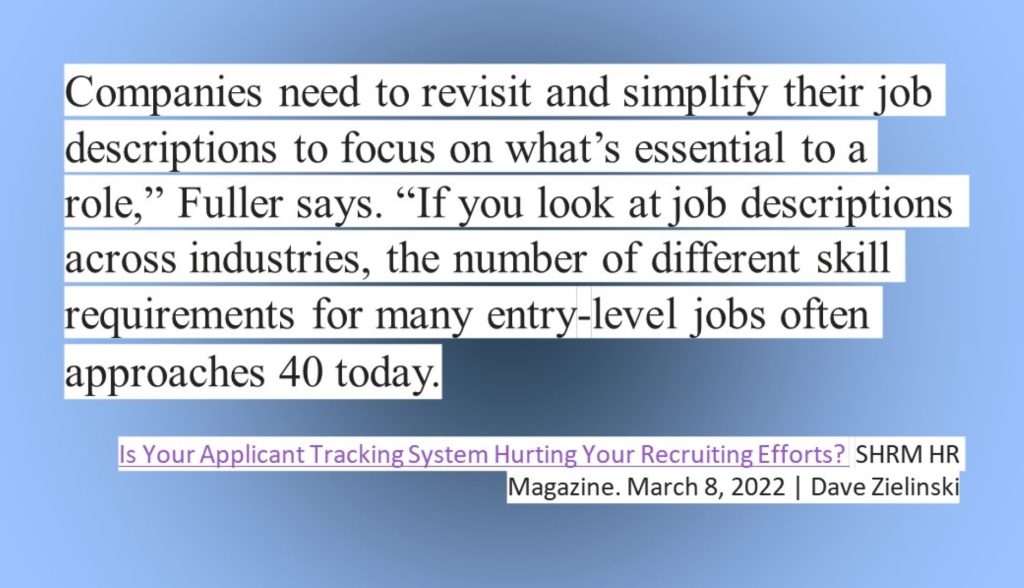 Yes they are, unless organizations pay close attention to how they function and how recruiters are using them. Applicant tracking systems (ATS) are software that human resource departments use to process volumes of resumes submitted for job openings. ATSs certainly are barriers to candidates who do not precisely fit the keyword search criteria or those who do not exactly match the job description. “Isn’t that the point? Applicant tracking systems rank the best candidates for the role.”
Yes they are, unless organizations pay close attention to how they function and how recruiters are using them. Applicant tracking systems (ATS) are software that human resource departments use to process volumes of resumes submitted for job openings. ATSs certainly are barriers to candidates who do not precisely fit the keyword search criteria or those who do not exactly match the job description. “Isn’t that the point? Applicant tracking systems rank the best candidates for the role.”
Not quite – the ATS recommends the candidates whose resume has the most job description keywords that appear in the resume and/or recommends resumes that match most closely the pre-determined selection criteria. This assumes that the job description and the pre-determined criteria are objectively correct and free of unintended biases.
Also, while applicant tracking systems have seemingly made things easier for employers to find the best candidate, they, in fact, have made it harder for organizations to find the right candidate. That is true unless the hiring manager is looking for a replica of the person who has left or the team that is there. Employers should be aware that using these systems may actually act contrary to recruitment goals that they are trying to achieve. Those goals could include bringing in change agents, innovation, diversity of thought and increased representation from equity denied groups. ATSs perpetuate the hiring of the exact same individuals from the exact same sector, likely a competitor company, who are moving upward on a spiral career ladder.
For organizations committed to creating diverse and equitable workplaces, they may be falling short because of an over-reliance on an ATS at the critical vetting stage. Yes, the sheer volume of resumes submitted likely necessitates the automation to whittle down the pool. It is a cost-saving and time saving mechanism. However, in this case, and even more importantly at senior level complex roles, it is important to understand the limitations of applicant tracking systems and to find ways to mitigate those limitations. These limitations are garnering attention because the impact is often the exclusion of immigrants, women, black people, people of colour and other equity denied candidates who are not able to leap over the hurdle that ATSs create.
Gaming the System?
Being able to jump over the hurdles that ATSs create requires candidates to understand a number of factors. First, candidates have to know that most North American organizations use an ATS as a screening tool and they have to know how they work. I have had many immigrants tell me about the hundreds of resumes they have submitted online, including for the exact same roles that they did in their countries of origin and being astounded that they don’t even get an initial screening call. One reason can be that for many of these systems, it is not good enough to use a word that contains the same root – it has to be the exact word. It can’t be ‘strategy’ if the job description contains ‘strategic’. It can’t be ‘building’ if the job description states ‘builder’. Also, though many candidates have been coached to create a unique and visually appealing resume, the format of the resume actually has to be very plain and simple for the ATS to be able to read it – no double columns, no shading, for example.
After becoming aware, some job seekers use the antidote of subscribing to a software like Job Scan. These tools ask candidates to upload the job description, their resume and cover letter and then it spits out a score to the degree to which there is a match. I was once told that one had to have at least a score of 80% for the first level recruiter (likely a recruiting coordinator, not the hiring manager) to even look at it. The problem that lies herein is that the job descriptions are often bloated – hiring managers/recruiters add on to the existing job descriptions, rather than evaluating the competencies and skills needed in the current operation of the role. So there may be dozens and dozens of words identified as ‘key’, especially when there are limited repeat words.
I have seen an example where Job Scan stated that over 40 technical skill words and 30 business skill words were needed in the resume and separately in the cover letter. This is a well-nigh impossible task – to morph a resume to reach that 80% would likely make the resume seem very artificial.  I have also heard through the employment-seeking grapevine the trick of putting those key words in a footer in white font, in order to game the system. I do not know if that works, as I have also heard that some systems can detect that. All of this begs the question as to why a candidate should have to try to ‘game’ a recruitment system in the first place.
I have also heard through the employment-seeking grapevine the trick of putting those key words in a footer in white font, in order to game the system. I do not know if that works, as I have also heard that some systems can detect that. All of this begs the question as to why a candidate should have to try to ‘game’ a recruitment system in the first place.
So the challenges to equity denied individuals are manifold including:
- Knowing that these systems exist
- Being able to manipulate the resume to a degree to pass the first-level barrier
- The cost of paying for an ‘antidote’ software
As a first test, I would encourage the hiring manager to take their resume or that of the employee who is leaving and to run it through the ATS against the job description that has been crafted. Would the hiring manager or the exiting employee pass the first level test? Secondly, these systems are not going to recommend candidates who bring fresh perspectives – they cannot analyze that a candidate has potential or innovative thinking.
The introduction of advanced artificial intelligence (AI) to ATSs promises to address the above concern. However, I would argue that ATSs, including those with advanced AI capability actually create greater risks to many of the equity goals that organizations have committed to achieving. But more on that next time…
